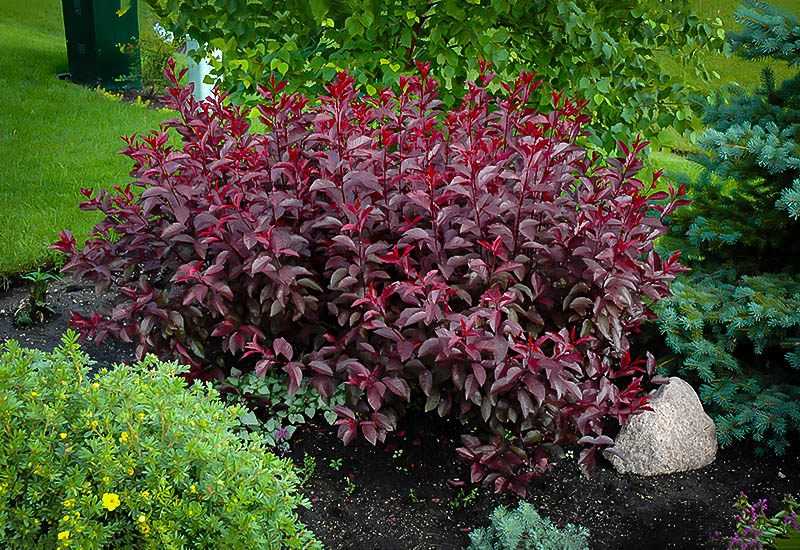Purple Sand Cherry: The Beautiful Shrub That Will Add A Pop Of Color To Your Garden
Introduction
If you're looking for a beautiful and easy-care shrub to add to your garden, look no further than the purple sand cherry. This stunning shrub is known for its vibrant purple foliage, which provides a pop of color in any landscape. Purple sand cherry is also a relatively low-maintenance plant, making it a great choice for busy gardeners.
What is Purple Sand Cherry?
Purple sand cherry (Prunus x cistena) is a hybrid shrub that is native to Asia. It is a cross between two other species of Prunus: purple leaf plum (Prunus cerasifera) and sand cherry (Prunus pumila). Purple sand cherry typically grows to be 6-8 feet tall and wide, and it can live for 20-30 years.
The Benefits of Purple Sand Cherry
There are many benefits to planting purple sand cherry in your garden. Here are a few of the most notable:
- Beautiful foliage: Purple sand cherry is known for its vibrant purple foliage, which provides a pop of color in any landscape. The leaves are typically a deep reddish-purple in spring, and they turn a bronze-green color in fall.
- Easy care: Purple sand cherry is a relatively low-maintenance plant. It is drought-tolerant and can withstand a wide range of soil conditions. It also does not require a lot of pruning.
- Attracts wildlife: Purple sand cherry is a popular plant for wildlife. The flowers attract bees and butterflies, and the fruits are eaten by birds.
How to Grow Purple Sand Cherry
Purple sand cherry is a relatively easy plant to grow. Here are a few tips:
- Choose a location: Purple sand cherry prefers full sun, but it can also tolerate partial shade. It is important to choose a location that is well-drained.
- Planting: Plant purple sand cherry in the spring or fall. Dig a hole that is twice as wide and as deep as the root ball. Backfill the hole with soil, and water well.
- Watering: Purple sand cherry is drought-tolerant, but it will need more water during the first year after planting. Water deeply once a week during the summer months.
- Pruning: Purple sand cherry does not require a lot of pruning. You can prune it in the spring to remove dead or damaged branches.
Conclusion
Purple sand cherry is a beautiful and easy-care shrub that is a great addition to any garden. If you're looking for a plant that will add a pop of color, attract wildlife, and be low-maintenance, purple sand cherry is a great choice.
Purple sand cherry is a beautiful and versatile plant that can be used in a variety of ways. It is native to North America and is known for its purple foliage, white flowers, and edible fruits. Purple sand cherry can be grown as a shrub, hedge, or small tree. It is tolerant of a variety of soils and conditions, and is deer resistant.
If you are interested in learning more about purple sand cherry, I recommend visiting the Home Gardening. This website has a wealth of information about the plant, including its history, cultivation, and uses.
FAQ of purple sand cherry
- What is a purple sand cherry?
A purple sand cherry is a deciduous shrub or small tree that is native to Asia. It is known for its beautiful purple foliage, which turns a brilliant scarlet in the fall. Purple sand cherries are also known for their fragrant white flowers, which bloom in the spring.
- How do I care for a purple sand cherry?
Purple sand cherries are relatively easy to care for. They prefer full sun to partial shade and well-drained soil. They are drought-tolerant once established, but they should be watered regularly during the first year or two after planting. Purple sand cherries are also susceptible to pests and diseases, so it is important to inspect them regularly and take preventive measures.
- How do I propagate a purple sand cherry?
Purple sand cherries can be propagated by seed, but they are more easily propagated by cuttings. To propagate a purple sand cherry from a cutting, you will need to take a 6- to 8-inch cutting from a healthy plant in the spring or summer. Remove the leaves from the bottom half of the cutting and dip the end in rooting hormone. Plant the cutting in a pot of moist potting mix and keep it in a warm, shady location. The cutting should root in about 6-8 weeks.
- What are some common problems with purple sand cherries?
The most common problems with purple sand cherries are pests and diseases. Some common pests that can attack purple sand cherries include aphids, scale, and spider mites. Some common diseases that can attack purple sand cherries include leaf spot, powdery mildew, and rust.
- How do I prevent problems with my purple sand cherry?
The best way to prevent problems with your purple sand cherry is to inspect it regularly for pests and diseases. If you see any problems, take action immediately to control the problem. You can also help to prevent problems by planting your purple sand cherry in a location that is well-drained and receives full sun to partial shade.



Post a Comment for "Purple Sand Cherry: The Beautiful Shrub That Will Add A Pop Of Color To Your Garden"